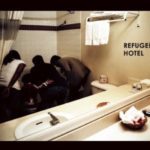Refugee Hotel (Voice of Witness)
Eyes closed, a thin young woman holds her hands up to her head. Her long dark hair flows halfway down the front of her body. Her fingers are perfectly manicured with dark nail polish. Although she looks quite young, she wears a gold wedding band on her finger. But the expression on her face draws one in, haunting and ethereal, almost in a state of troubled tranquility. She is just one of the refugees photographed in an eloquently moving book, Refugee Hotel, with text by Juliet Linderman and photographs by Gabrielle Stabile.
Refugee Hotel is a provocative collection of photographs and oral histories. The experiences of men and woman who have resettled in America from Bhutan, Burma, Iraq, Burundi, Somalia, and Ethiopia. Their unique stories convey the hardships they’ve endured getting to America and the adjustment to the new life they found here.
Refugees tend to settle in areas where other refugees from their country can be found. In Amarillo, Texas refuges from Burma, Iraq and Somali can be found. 30-year-old Do Lian Zam, aka “Elis,” traveled from “Tedim City, Burma to Bangkok, Thailand to Kuala Lumpur, Malaysia to Hong Kong to Los Angeles, California to Houston, Texas to Amarillo, Texas.” While he was living in Malaysia he was arrested for being an illegal immigrant and spent 9 months in jail before the United Nations High Commissioner for Refugees (UNHCR) gave him a refugee card and allowed him to come to America. His troubled life led him to live in fear. When he got to America he “thought, Who is going to pick me up? Who is going to take care of me? Where I had to go, I didn’t know. I didn’t know anything. But when I went outside the hotel, people smiled and said hello, and it refreshed my heart; my heart was open.”

We never learn the name of the woman in the photograph. She is only identified in a photographic key, at the back of the book, as being a native from Burma who now lives in Saint Paul, Minnesota. Those whose oral histories we learn are never matched with their photographs, only their native homelands and the American cities where they now live. Everyone who appears in the photographs in this tome remains anonymous.
Felix Lohitai , age 48, traveled from “Rokon, South Sudan to Agojo refugee camp, Uganda to Dadaab refugee camp, Kenya to Nairobi, Kenya, to Brussels, Belgium to Newark, New Jersey to Saint Paul, Minnesota to Waterloo, Iowa to Grundy Center, Iowa to North Manchester, Indiana to Erie, Pennsylvania” where he now lives. He now works for “Habitat for Humanity to facilitate home ownership for refugees.” He has been living in America since 2003, “this is my country now, and I will be a U.S. citizen; I will carry a U.S. passport. When I first was chosen to come here a caseworker told me, ‘You are going to the United States. That is your country, and don’t ever, ever feel like a stranger.’ Everybody in America is a stranger when they first arrive. But in 50 years our grandchildren will just be like everybody else.”
